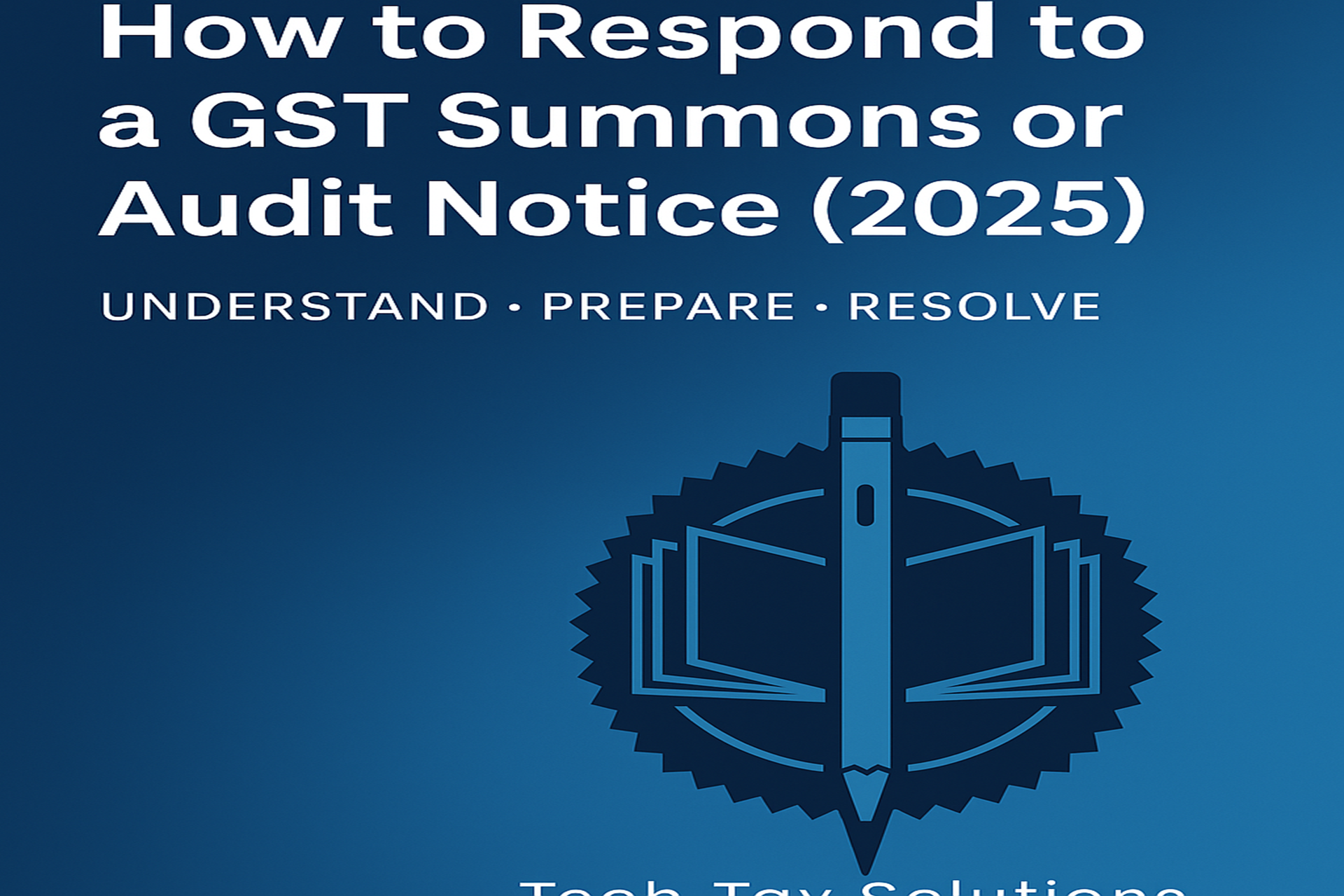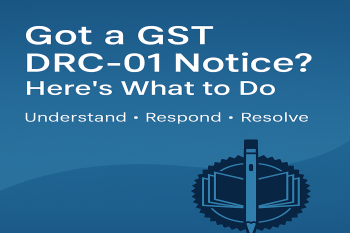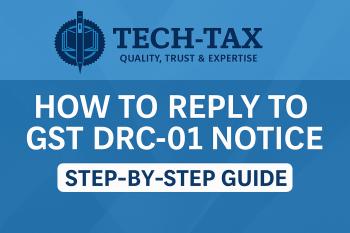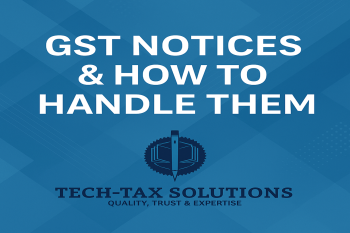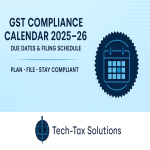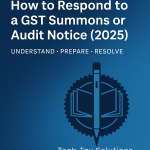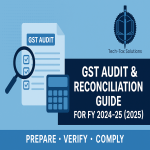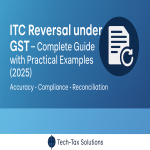🔹 Introduction
Receiving a GST summons or audit notice can be intimidating for any business owner — but it doesn’t always mean you’ve done something wrong.
The GST Department issues these notices to verify data accuracy, ensure tax compliance, and reconcile discrepancies in returns or invoices.
If handled properly, a summons or audit can be closed without penalty or further action.
This article explains what a GST summons or audit notice means, why it is issued, and how to respond effectively under the latest GST provisions in FY 2025–26.
🔹 Legal Framework
The power to issue notices and conduct audits under GST arises from the following provisions:
-
Section 65 of the CGST Act, 2017 – Audit by tax authorities.
-
Section 66 – Special audit by a Chartered Accountant or Cost Accountant.
-
Section 70 – Power to summon persons to give evidence and produce documents.
-
Rule 101–102 of the CGST Rules, 2017 – Audit procedures.
-
Section 73 & 74 – Determination of tax not paid or short paid.
📘 Objective:
To verify tax compliance, detect discrepancies, and ensure that ITC, outward supplies, and tax payments are accurate and genuine.
🔹 Types of Notices Related to GST Audit or Summons
| Notice Type | Form / Section | Purpose |
|---|---|---|
| GST Audit Notice | Section 65 | General audit of books and returns. |
| Special Audit | Section 66 | Ordered when complexity or mismatch is high. |
| Summons | Section 70 | To compel attendance or submission of documents. |
| DRC-01 / DRC-01A | Section 73/74 | Issued after audit to demand tax or seek clarification. |
| ADT-01 | Rule 101(2) | Official intimation of audit commencement. |
🔹 Common Reasons for Receiving a GST Audit or Summons
-
Mismatch between GSTR-1, GSTR-3B, and financial statements.
-
Ineligible or excess ITC claimed as compared to GSTR-2B.
-
Non-filing or delayed filing of returns.
-
Underpayment or non-payment of GST liabilities.
-
Significant differences between turnover reported in income tax and GST.
-
Suspicious transactions detected through data analytics or AI-based risk engines.
-
Third-party verification of supplier or recipient accounts.
💡 Note:
Summons may also be issued to gather information during another taxpayer’s audit or investigation.
🔹 Step-by-Step: How to Handle a GST Audit or Summons
✅ Step 1: Read the Notice Carefully
-
Check notice number, issuing officer, date, and reference section.
-
Identify whether it’s under Section 65, 66, or 70.
-
Note the timeline for response and documents required.
📌 Tip: Always verify the authenticity of the notice on www.gst.gov.in.
✅ Step 2: Collect & Organize Documents
Prepare the following (as applicable):
-
GST Returns (GSTR-1, 3B, 9, 9C) for last 2–3 years.
-
Sales and purchase registers.
-
Books of accounts (ledger, trial balance, P&L).
-
E-way bills, invoices, delivery challans.
-
Bank statements for the audit period.
-
ITC reconciliation report (GSTR-2B vs books).
-
Tax payment challans and DRC-03 details.
✅ Step 3: Reconcile Data Before Submission
-
Match turnover from books vs GSTR-1/3B.
-
Match ITC claimed vs GSTR-2B.
-
Identify any unpaid or excess tax.
If discrepancies exist, consider voluntary payment via Form DRC-03 before submission.
✅ Step 4: Prepare a Professional Reply
Respond in writing, preferably in Form DRC-06 (for explanation) or a formal letter addressing each query raised.
Attach supporting documents and reconciliations.
📩 Submit your reply within the due date mentioned in the notice to avoid further action.
✅ Step 5: Attend Hearings or Provide Clarifications
-
If summoned under Section 70, personal appearance or representative attendance is mandatory.
-
Be respectful and cooperative.
-
Submit all required records and clarify your position truthfully.
✅ Step 6: After the Audit
-
You may receive a Findings Report or DRC-01/DRC-07 notice if discrepancies remain.
-
If satisfied, the officer may close the case with no further action.
-
Retain all correspondence and audit reports for your records.
🔹 Practical Example
Example:
M/s Stellar Machines Pvt. Ltd. received a GST audit notice (ADT-01) under Section 65 for FY 2023–24 due to ITC variance of ₹2.2 lakh.
After reconciling, they discovered a supplier had filed GSTR-1 late.
They replied through DRC-06 with proof of subsequent filing and payment confirmation.
📊 Result: Audit closed without any demand.
🔹 Common Mistakes to Avoid
❌ Ignoring the notice or missing the response deadline.
❌ Submitting incomplete or inconsistent data.
❌ Providing oral statements without written backup.
❌ Not taking professional help for reconciliation or drafting replies.
❌ Assuming summons = penalty — it’s often an opportunity to clarify.
🔹 Best Practices
✅ Maintain year-round reconciliations to avoid last-minute panic.
✅ Keep digital and physical copies of invoices and ledgers.
✅ File returns on time and ensure supplier compliance.
✅ Train your accounts team to handle audit queries properly.
✅ Seek professional representation during hearings for complex cases.
🔹 Penalties & Consequences (if not handled properly)
| Default | Section | Consequence |
|---|---|---|
| Non-response to notice | Section 70 | Summons enforcement + prosecution risk |
| Non-cooperation during audit | Section 65(6) | Best judgment assessment |
| False information or suppression | Section 74 | 100% penalty of tax evaded |
| Failure to produce documents | Section 125 | General penalty up to ₹25,000 |
🔹 FAQs
Q1. What is the difference between a GST audit and summons?
➡️ An audit verifies your books and compliance; a summons compels you to provide documents or appear before the officer.
Q2. Can I authorize my accountant or consultant to appear on my behalf?
➡️ Yes, through a written authorization letter or GST practitioner authorization.
Q3. How long does a GST audit take?
➡️ Usually completed within 3 months, extendable up to 6 months.
Q4. What if I disagree with audit findings?
➡️ You can submit written objections and, if necessary, file an appeal against the order.
Q5. Can Tech-Tax Solutions assist in GST audit defense?
➡️ Absolutely. We specialize in GST audit support, DRC-01 replies, and departmental representation.
🔹 Conclusion
A GST summons or audit notice is not a penalty — it’s an opportunity to demonstrate compliance.
By responding professionally, maintaining accurate reconciliations, and cooperating with authorities, businesses can close audits smoothly without disputes.
📌 For expert help in drafting replies, audit representation, or GST reconciliation, contact Tech-Tax Solutions – Quality, Trust & Expertise in Ghaziabad, Noida & Delhi.
